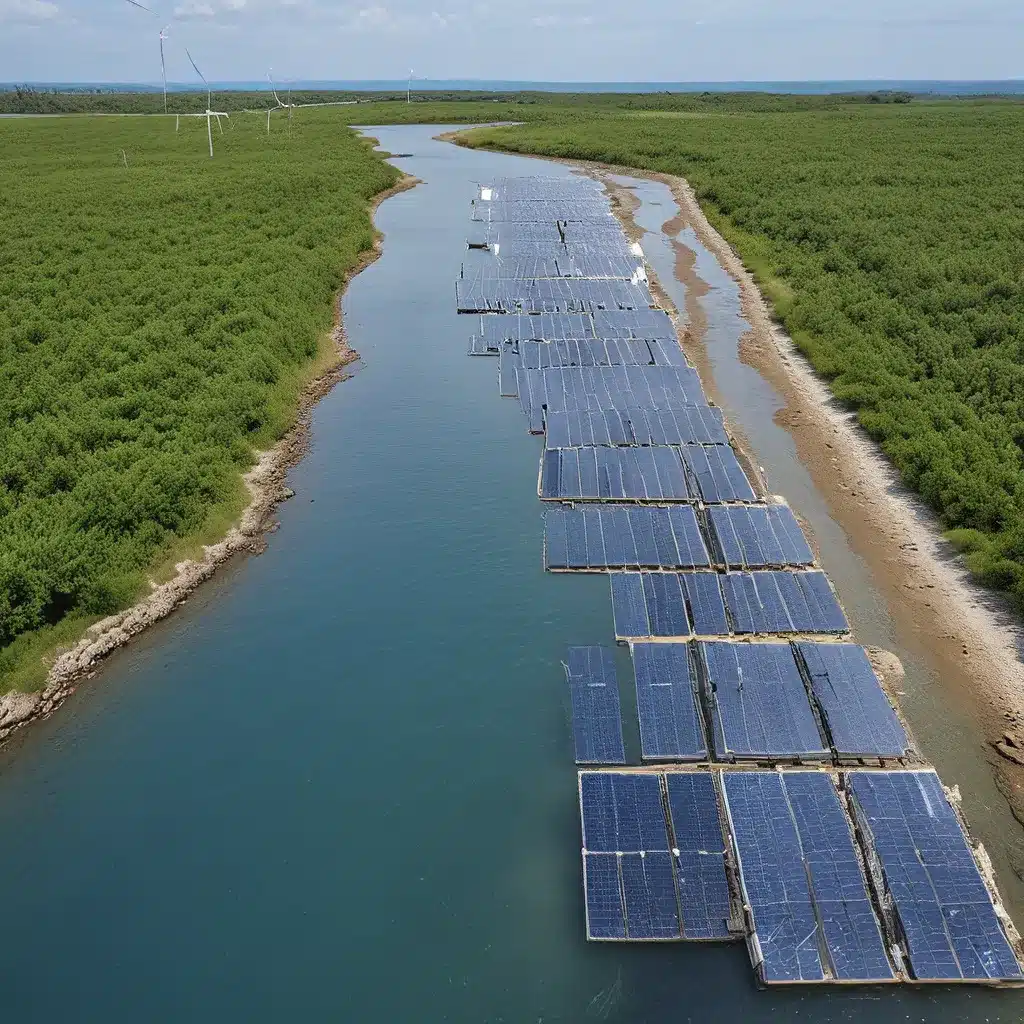
Unlocking the Potential of the Seas
As the world grapples with the urgent need for renewable energy solutions, a fascinating and largely untapped frontier has emerged – the blue economy. This dynamic ecosystem encompasses a vast array of maritime industries, from aquaculture and ocean exploration to renewable energy generation. And at the heart of this revolution lies the potential for marine renewable energy to power the blue economy, unleashing a new era of sustainable growth and innovation.
I’ve been fascinated by this intersection of renewable energy and the oceans ever since I stumbled upon the groundbreaking work of the U.S. Department of Energy’s Water Power Technologies Office (WPTO). Their “Powering the Blue Economy” initiative has been a true eye-opener, illuminating the remarkable opportunities that lie just offshore.
Aquaculture’s Energy Challenges
One of the most compelling aspects of the blue economy is the rapid growth of aquaculture – the farming of aquatic organisms like fish, crustaceans, and mollusks. As global demand for seafood continues to skyrocket, aquaculture has emerged as a critical solution to meet this need in a sustainable manner. However, as these aquaculture operations move further offshore to take advantage of the vast scale of the oceans, a significant challenge has arisen: the need for reliable, consistent power.
Traditional land-based power grids simply can’t keep up with the energy demands of these offshore facilities. Imagine trying to power a state-of-the-art fish farm miles from the nearest shoreline – it’s an immense logistical hurdle. That’s where marine renewable energy comes into play, offering a game-changing solution to this pressing problem.
Harnessing the Power of the Tides and Waves
The oceans are teeming with untapped energy potential, from the rhythmic ebb and flow of the tides to the powerful undulations of waves. Marine energy technologies, such as tidal and wave energy converters, are poised to capture this abundant, renewable resource and channel it directly to the blue economy’s power-hungry operations.
Imagine a fish farm powered entirely by the ocean’s own energy – no more reliance on costly and carbon-intensive diesel generators or precarious connections to the onshore grid. This is the future that marine renewable energy is ushering in, and it’s a future that’s closer than you might think.
Firewinder, a leading provider of renewable energy solutions, is at the forefront of this revolution. By integrating cutting-edge marine energy technologies into their product offerings, they’re empowering coastal and maritime enterprises to tap into the limitless potential of the seas.
Powering Coastal Communities and Beyond
But the benefits of marine renewable energy extend far beyond the aquaculture industry. Coastal communities, often vulnerable to the impacts of climate change and extreme weather events, can find newfound resilience and energy security by harnessing the power of the oceans.
NREL, the National Renewable Energy Laboratory, has been at the forefront of this research, exploring how marine energy can support coastal communities and make them more resilient in the face of natural disasters. Their work has shown that wave-powered desalination systems, for example, can provide a reliable source of clean drinking water, even in the aftermath of a devastating hurricane or tsunami.
Revolutionizing Ocean Exploration and Observation
The opportunities for marine renewable energy don’t stop there. The Ocean Observing Prize, a collaboration between the WPTO and NREL, is challenging innovators to integrate marine energy with ocean observation platforms. This could revolutionize our ability to collect the crucial data needed to understand and map the vast, largely unexplored oceans.
Imagine a network of autonomous underwater vehicles, powered by the endless currents and waves, tirelessly gathering data on marine ecosystems, weather patterns, and climate change. This is the future that marine renewable energy is helping to create – a future where we can better steward the health and sustainability of our oceans.
Overcoming Challenges and Driving Innovation
Of course, the path to realizing this vision is not without its challenges. Technological barriers, such as improving the efficiency and reliability of marine energy converters, must be overcome. Economic hurdles, like the high upfront costs of these emerging technologies, also need to be addressed.
But the Water Power Technologies Office, through initiatives like the Waves to Water Prize and the Ocean Observing Prize, is driving innovation and supporting the development of these critical solutions. By fostering collaboration between researchers, engineers, and industry leaders, they’re paving the way for a future where the oceans are not just a source of sustenance, but a wellspring of renewable energy.
Embracing the Blue Economy’s Boundless Potential
As I’ve delved deeper into this topic, I’ve been struck by the sheer boundless potential of the blue economy. From aquaculture to ocean exploration, the opportunities for marine renewable energy to transform these industries are truly staggering.
And the best part? We’re just scratching the surface. The Powering the Blue Economy report, published by the WPTO, has identified a compelling set of eight blue economy opportunities that could be supported by marine and hydrokinetic technologies. This suggests that the full extent of the oceans’ energy-generating potential is yet to be discovered.
So, as we grapple with the pressing need for sustainable energy solutions, let’s turn our gaze seaward. The blue economy is poised to become a crucial piece of the renewable energy puzzle, and marine renewable energy is the key to unlocking its boundless potential. The future is here, and it’s being powered by the very tides and waves that have shaped our world for millennia.

